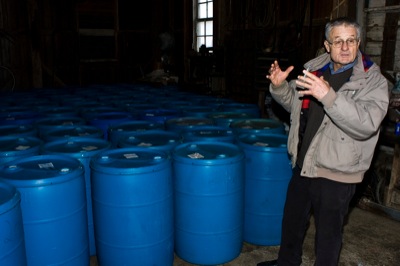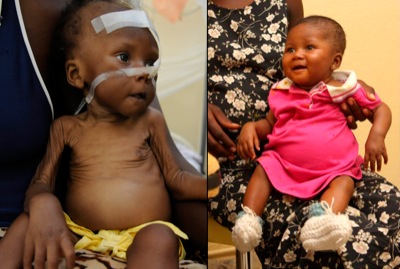Thursday, December 5th, 2013
Renner feeds need in Haiti
By Doug Drexler

Photo by Mark Pummell/The Daily Standard
Brother Nick Renner prepares a shipment of high-protein soy meal for delivery to Haiti, where it helps fight malnutrition in pregnant women and children up to age 5.
BURKETTSVILLE - A 1975 visit to the impoverished island nation of Haiti eventually led Brother Nick Renner to a "hobby" that has improved countless lives.
"People are hungry. That's what I see," he said, referring to those living in the mountain villages near Jeremie, Haiti.
Poor nutrition has made people docile and their ability to think critically is limited.
Renner is trying to rectify the situation by shipping high-protein soybean meal to the Haitian Health Foundation in Jeremie. Foundation workers take the supplement to 104 remote villages.
"Some of them you drive to. Some you just walk to," because there are no roads, only footpaths or trails, Renner said.
Pregnant women and children up to age 5 take the meal and mix it into other food to add some protein and fat to their diet.
"They're supposed to use it as a vitamin," he said, adding 5,000 women and children in the villages are eligible for help under the program. Villagers' diets consist mainly of roots and beans and native fruit. In tough times, people resort to mixing in organic earth to add some vitamins and minerals, he said.
Their lives are stripped to the basics and they have few dreams or hopes, he said.
"You just try to keep their belly full," he said.
The lack of nutrition is especially damaging to the developing brains of children before they are born and in the first five years of life. Part of the problem is a Voodoo belief that pregnant women should try to keep their weight and the baby's weight down to make childbirth easier, said Renner, who is a brother in the Precious Blood order. He is based at Immaculate Conception Parish in Celina and also works in rural Mercer County through St. Charles in Carthagena.
Marilyn Lowney of HHF said Renner's project has been a great help in the foundation's efforts to fight malnutrition and improve the lives of the youth in the region.
"Every time a child goes into malnutrition, it loses IQ points," she said.
The area has a particular problem with kwashiorkor malnutrition, a protein deficiency. The condition stunts growth and mental development of children and is difficult to fight.
"Protein-rich foods like meat are very expensive," she said.
As a result, the Haitians tend to eat cheaper foods, which are high in carbohydrates but low in protein.
"Brother Nick's food comes in very handy. It's very well received," she said.
The group must make an 18-hour walk to get the meal to some of the remote villages, she said. The foundation has trained health workers to track the progress of women and children in the program, and the children are improving, she said.
"When we started to go down there, we saw stick babies with bloated bellies," she said.
The foundation began to go to Haiti in 1982 and moved to Jeremie in 1985. It now runs a facility to help children with second- and third-degree malnutrition, which hinders them from feeding themselves. Some of the children have gone blind.
Renner has gathered donations and rounded up a team of about 15 volunteers, most of whom are retired. The group helps him collect 55-gallon food-grade barrels from around the county. The team cuts off the lids and cleans out the barrels with boiling water and removes any labels.
Renner uses donations to buy a special blend of soy meal that has a fat level boosted to about 7 percent and a protein content of about 40 percent from Mercer Landmark, Rockford. His team puts a lining into the barrels and fills them with the meal at a farm the Precious Blood owns in Burkettsville. They then flip the removed tops upside down and reattach them with screws - a trick it took him two years to come up with, Renner said. He could not pull off the effort without his dedicated volunteers
"I want to thank them for Haiti," Renner said.
His team packs 120 barrels, 20 tons of meal, into a shipping container. Once in Haiti, the meal is distributed to the villages within two to three weeks, he said.
When he started the project five years ago, he shipped canned meat and soybeans in sacks. However, he found the bean meal to be more efficient, and about four years ago he switched to using barrels because sacks were more vulnerable to vermin and spoilage.
The barrels also serve an additional purpose. Once the meal is removed, the Haitians collect river water in them and allow the sun to heat the water. The temperature rises enough to kill bacteria and make the water safer to drink.
"They love these barrels for water distillation," he said.
Renner tries to send one to two shipments a year to Haiti. He's also shipped the meal to charities in Tanzania in Africa and Jamaica. Sometimes, he has sent partial shipments of the meal along with other supplies. Recently a shipment to the Precious Blood missionaries in Tanzania contained a partial shipment of meal and school desks to fill the container. The added supplies make the effort more efficient by using all the shipping space.
"I want to get the biggest bang for my buck," he said.

Submitted Photo
Blondina is a 1-year-old child who was admitted to the Center of Hope in Haiti due to malnutrition. She weighed 7 pounds at the time. She began recuperating, through nasogastric tubes, and is shown at right about six weeks later completely recovered.



